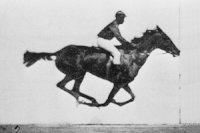
Photo from wikipedia
ABSTRACT Transitions to terrestrial environments confront ancestrally aquatic animals with several mechanical and physiological problems owing to the different physical properties of water and air. As aquatic feeders generally make… Click to show full abstract
ABSTRACT Transitions to terrestrial environments confront ancestrally aquatic animals with several mechanical and physiological problems owing to the different physical properties of water and air. As aquatic feeders generally make use of flows of water relative to the head to capture, transport and swallow food, it follows that morphological and behavioral changes were inevitably needed for the aquatic animals to successfully perform these functions on land. Here, we summarize the mechanical requirements of successful aquatic-to-terrestrial transitions in food capture, transport and swallowing by vertebrates and review how different taxa managed to fulfill these requirements. Amphibious ray-finned fishes show a variety of strategies to stably lift the anterior trunk, as well as to grab ground-based food with their jaws. However, they still need to return to the water for the intra-oral transport and swallowing process. Using the same mechanical perspective, the potential capabilities of some of the earliest tetrapods to perform terrestrial feeding are evaluated. Within tetrapods, the appearance of a mobile neck and a muscular and movable tongue can safely be regarded as key factors in the colonization of land away from amphibious habitats. Comparative studies on taxa including salamanders, which change from aquatic feeders as larvae to terrestrial feeders as adults, illustrate remodeling patterns in the hyobranchial system that can be linked to its drastic change in function during feeding. Yet, the precise evolutionary history in form and function of the hyolingual system leading to the origin(s) of a muscular and adhesive tongue remains unknown. Summary: Any aquatic vertebrate aiming for a terrestrial lifestyle must change from its aquatic to a terrestrial feeding mechanism, and we synthesize mechanical challenges associated with such aquatic–terrestrial transitions in vertebrates.
Journal Title: Journal of Experimental Biology
Year Published: 2018
Link to full text (if available)
Share on Social Media: Sign Up to like & get
recommendations!